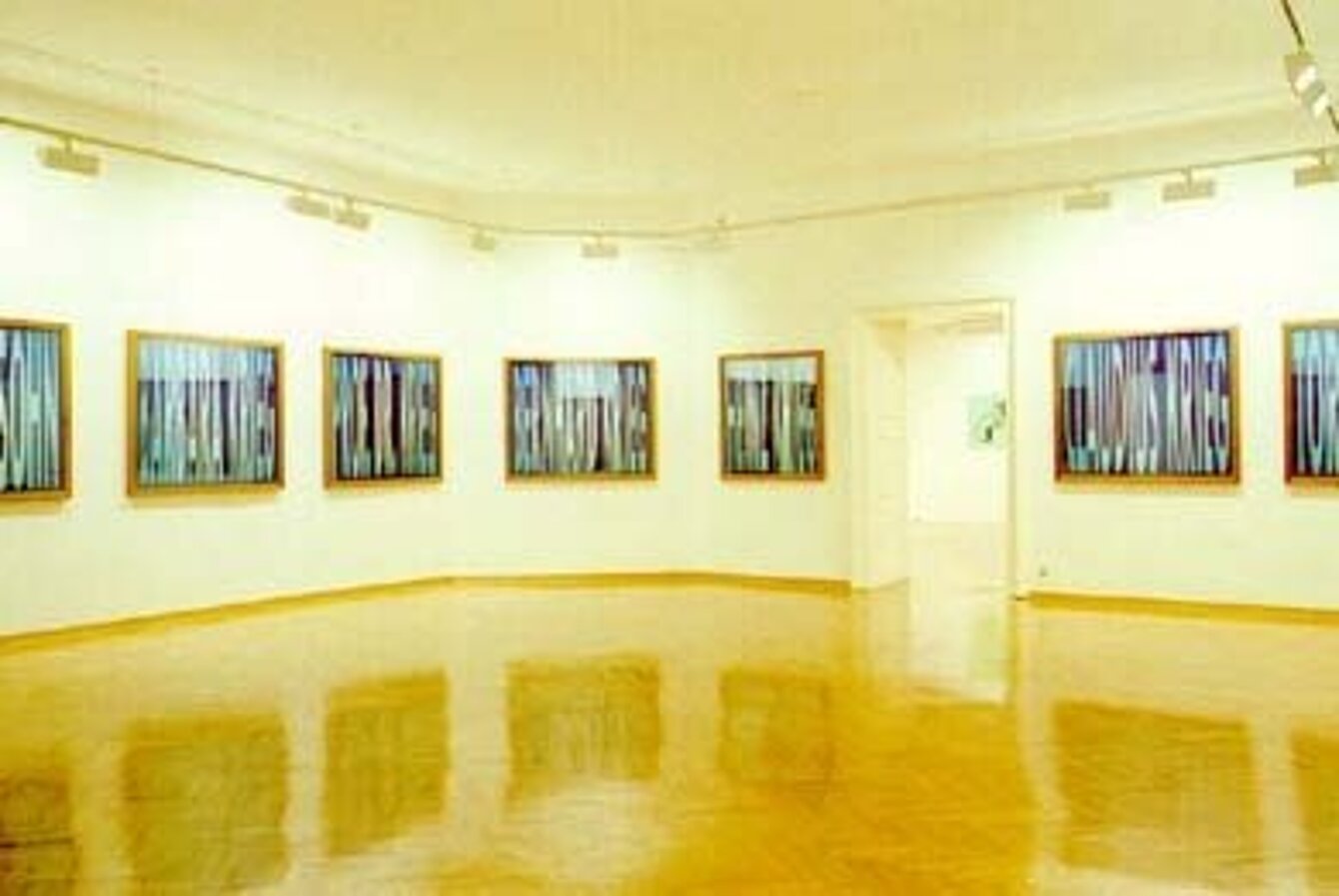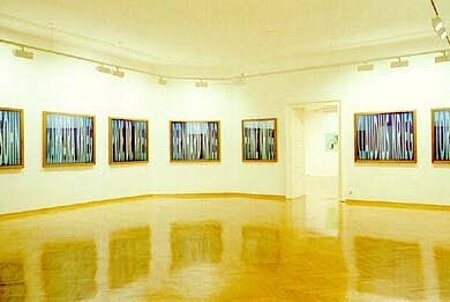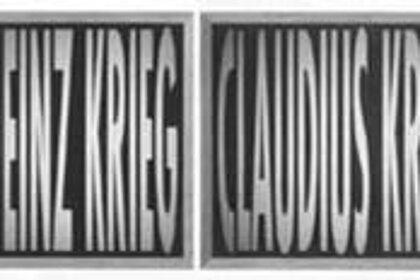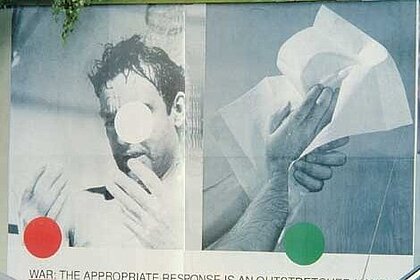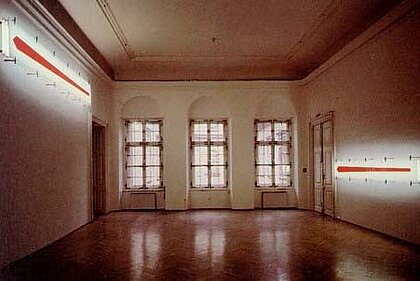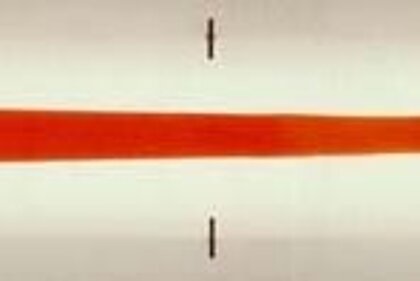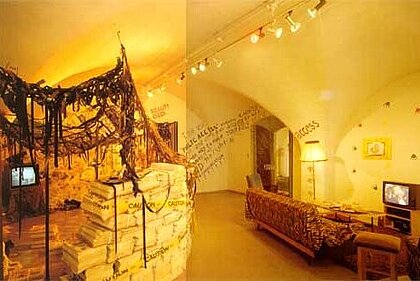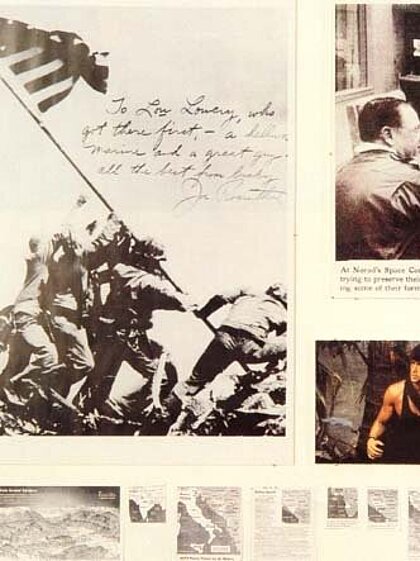The exhibition was accompanied by a catalogue in Edition Camera Austria with articles by Bogdan Bogdanovic (Serbia), Burghart Schmidt (Austria), Fred Ritchin (USA), Harun Farocki (Germany), Dzevad Karahasan (Bosnia-Herzegovina), Herta Wolf (Austria), Dubravka Ugresic (Croatia).
The Triennial on Photography is commissioned by the Austrian Ministry of Art since 1993 and is based on an idea of Werner Fenz.um seit 1993 veranstaltet und geht zurück auf eine Idee von Werner Fenz.
WAR.
Preparations for the WAR. exhibition began in early 1993. There was a practically inescapable logic in relating this photographic event to the disaster taking place in former Yugoslavia, only a few hours away from Graz - an equally artistic and real life logic. The project was not meant to remain on a self-reflective level, within the confines of photographic artistic practice; it was not to be limited to the investigation of methodical and formal decisions or a definition of positions within the realm of photography. Rather, the intention was to place the medium before the background of historical reality. A challenge to an artistic discipline habitually dealing with the real? It is, in any case, an experiment and, as such, it also allows for failure as a possible answer. What reaction to a situation of WAR. is possible within the photographic debate - how can this complex formation be made "visible". designated and incorporated in an artistic production?
Choosing WAR. as a topic is to place any expression, any statement (made today) in the context of WAR. Searching for possible forms of expression, for ways to describe and deal with WAR., is crucial in a situation where commentary and illustration (the main functions commonly associated with photography) have lost their credibility; a situation where reality is seen (has come to be seen) as mediated, so that nothing short of an assault on the body seems capable of introducing a reality experienced as real. Such an experience might serve to overcome the immunity effected by everyday violence.
With a theme like WAR. (which creates an additional background, in terms of photographic history, as a strategic and propagandistic device), we believe that this exhibition project should be doubly effective: Focussing on a specific event, we address the general conditions of an artistic discipline dealing with reality. With reference to photography, a principally depictive medium, these conditions imply a specific challenge - to articulate, in a language in keeping with the spirit of our day, whatever is visible and thinkable of reality, whatever is comprehensible of its fragments.
Life can only be narrated from the viewpoint of death. Likewise, our view of historical events is always retrospective. We have no other choice but to articulate our perspective as "viewers from outside". This is demonstrated by the selection of artists who have contributed to this project from varied political environments and with varied subjective attitudes. Text contributions and artist's works play an equally important role: The inside view is supplied by three text authors from former Yugoslavia. The first volume of the catalogue contains thematically relevant works by the contributors. lt leads up to the projects especially created for the WAR. exhibition. The second volume documents, in depth, the exhibition as such.
We express our thanks to the artists and text authors for their willingness to join us in confronting this theme and this undertaking. The "Austrian Triennial on Photography 1993" was made possible by the support of the Ministry of Education and Art. Substantial sponsoring was also provided by the Province of Styria and the City of Graz.
Werner Fenz, Christine Frisinghelli
Artists:
Dennis Adams (USA) · · · Iris Andraschek (A) · · · Art in Ruins (GB) · · · Bader & Tanterl (D) · · · John Baldessari (USA) · · · Sabine Bitter (A) · · · Christopher Bledowski (CH) · · · Krzysztof Cichosz (PL) · · · Michel Dector / Michel Dupuy (F) · · · Willie Doherty (IRL) · · · Seiichi Furuya (J) · · · Georg Herold (D) · · · Horàkovà & Maurer (CZ / A) · · · Gerald van der Kaap (NL) · · · Herwig Kempinger (A) · · · Astrid Klein (D) · · · Verena Kraft / Kurt Petz (D) · · · Elke Krystufek (A) · · · Zofia Kulik (PL) · · · Wladimir Kuprijanow (GUS) Paper Tiger Television (USA) · · · Philippe Perrin (F) · · · Pierre et Gilles (F) · · · Martha Rosler (USA) · · · Michael Schuster (A) · · · Andrea Sodomka (A) · · · Andrea van der Straeten (D) · · · Matta Wagnest (A) · · · Nick Waplington (GB) · · · Manfred Willmann (A)
Contributions
Bader & Tanterl
Bader and Tanterl have delivered images that take the subject at its word. [...] Calling the name of WAR will continually address the existence of war. In this instance, its articulation occurs exactly at the interface between anonymity and private individuality, with metaphor enshrined in the work of art itself. Its cross-references will invoke associations of images beyond the one that was originally given. Any further annotation is dependent on the perceptive behaviour of the spectator.
Werner Fenz, An Insight into Depicitions about WAR.
Translation: Jörg von Stein
John Baldessari
Only when the irritation and disruption reaches the point it does in John Baldessari´s work, only when images are as transient as their presence on billboards around town for the space of a few weeks, only when their message is being submerged by other messages, only then will it become possible to utter - simply and without assuming authority - the words: "War: The Appropriate Response is an Outstretched Hand."
Christine Frisinghelli, WAR.
Translation: Bärbel Fink
Horáková & Maurer
The etymological reading Cravatte/Cravat/Croat might be connotational - an explanation is it not. It is the object itself and its semiotic anchoring which catch the eye and tempt you into trying to extract meaning from an insignificant object. On a level of meaning and content, which the visitor will primarily confront within the context of the exhibition theme, the work oscillates between its familiarity as an everyday object on the one hand, and its alien nature within the context. Sheer profanity should save it from acquiring any unofficial portent, though there is, of course, no guarantee.
Werner Fenz, An Insight into Depicitions about WAR.
Translation: Jörg von Stein
Paper Tiger Television
TARGET AUDIENCE (1993)
This installation recreates two environments where people gather during war-time: In the military bunker and around the living-room TV set. The bunker suggests our reality as citizens in a consumer society, bombarded by the TV News with language and images. These news products launder, glamorize, and distort the reality of war to serve international corporate agendas.
Paper Tiger Television
Martha Rosler
The intention of the photgraphic array "It Lingers", 1993, for the exhibition WAR. is to invoke iconic images of war, particularly the Second World War, partly in relation to the current war in the former Yugoslavia. The installation centers on an image important in my country, the United States, and on one from the country that is the site of the exhibition, Austria. Some other images and texts are included . The work intends to invoke the relationship between celebrations of war and remembrances of history and the militarization of everyday life.
Martha Rosler




















